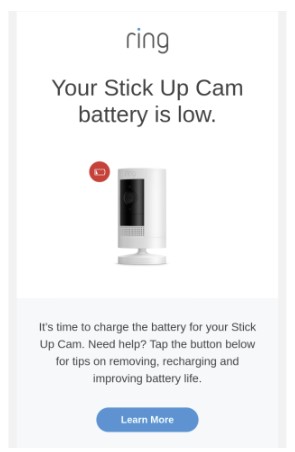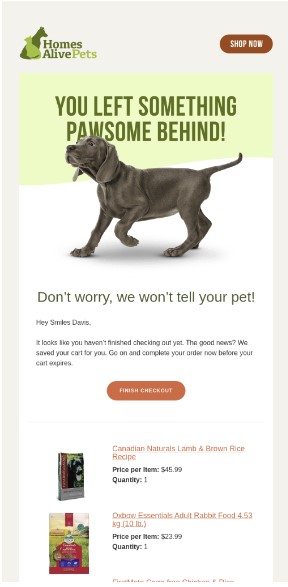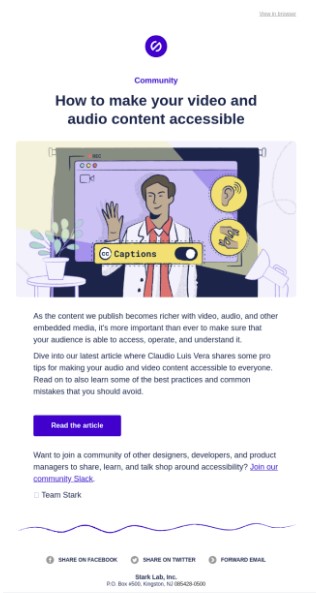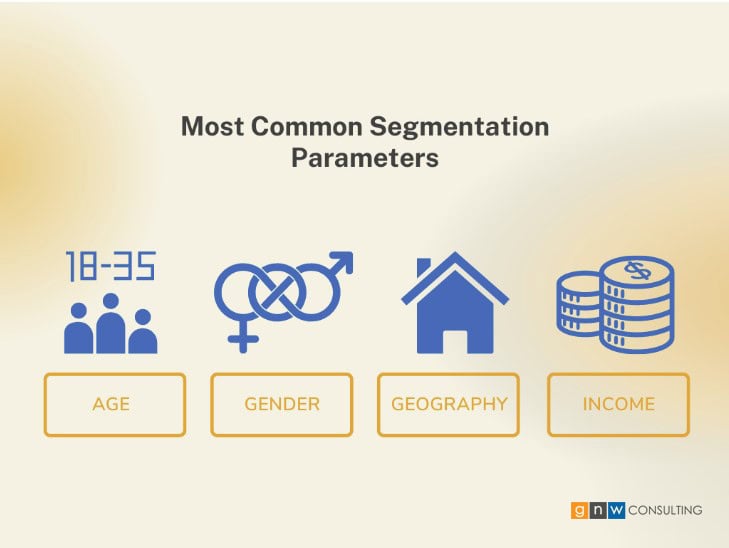Many marketers think in terms of the marketing funnel, but we find that often the most overlooked question we see when working with clients is “what is your current lead nurturing strategy?” A few blank stares later and it’s clear that they haven’t quite taken their audience to the finish line and beyond. Nurturing shouldn’t be the last thing marketers think about, but rather it should effortlessly drive the customer journey along. If you know where you want your clients to end, it’s easier to plan the route, then rinse and repeat for years of many happy customers.
We will begin by introducing the types of nurture we find most successful, using the right tactics and when, and last, but not least, why nurturing is important, here’s our quick agenda:
Types of Nurture Campaigns
We’ll start this one with our top 6 most used nurture campaign types, while this list is not exhaustive, we think it’s extensive enough to prepare you for the type of strategic thinking you’ll need to think about as you plan the use journey.
Discount Nurtures
You guessed it, this type of nurture is the perfect method to motivate existing customers to make a purchase. We recommend trying this one next time you’re considering a loyalty or rewards program for choosing your brand.
💡Pro tip: the goal of discount campaigns can vary based on user segments.
Source: ReallyGoodEmails.com
Promotion Campaign Nurtures
A promotion campaign allows brands to issue a direct call to action such as buy, signup or subscribe. This type of campaign can work for new and active customers depending on the type of action you want to drive focus toward. We recommend heavy personalization to drive brand loyalty here.
Source: ReallyGoodEmails.com
Reminder Campaign Nurtures
One of our favorite types of nurture campaigns, and easily one of the easiest to set up is a reminder campaign. Reminder emails warn customers who may have forgotten their trial period is ending or as a gentle nudge that their subscription is renewing. These can also be used to remind clients to stock up or as a reminder to charge their battery as this clever ring email shows.
Source: ReallyGoodEmails.com
Nuture an Abandoned Cart/Unfinished Process
While this may seem common and straightforward, we actually recommend making these type of emails as clever as possible. They’ll require an in-depth knowledge of the consumer, when is the best point to convert? What type of messaging works? It’s all a science and tracking variables is just half of the story. The other half? Writing an email that incites users to finish the purchase process.
Source: ReallyGoodEmails.com
Welcome Campaigns
Another great example of low hanging fruit in terms of kicking off a nurture strategy. Welcome emails are the most opened types of nurture emails. It’s a perfect time to give users an overview of your brand, but don’t overload the email with extra information, prioritize what’s important and make your audience feel introduced and welcome. This example really shows how you can feature CTAs while not pushing a hard sell.
Source: ReallyGoodEmails.com
Content Nurture Campaigns
Many people think of these as newsletters or any type of email that isn’t about making a sale in that moment, but rather help to build trust in the brand. It’s important to share useful information such as videos, guides and articles, but always lead with the intent to inform audiences with this type of nurture.
Source: ReallyGoodEmails.com
“ We always recommend clients to take a step back and think of what existing and new customers would want out of loyalty nurtures. Think of examples such as McDonald’s deals or Nike waitlists and start building different triggered emails around desired user behaviors. ” - Raja, GNW Consulting
This isn’t meant to be an exhaustive list of every type of nurture email one can send, but these examples can build a strong foundation to help you retain the business you worked hard to earn. Be cautious of how and when you use each tactic, there’s nothing more embarrassing than sending an unhelpful email to the wrong person, so be sure to keep that recipient top of mind. Let’s segway a bit more into what using the right tactic for the job looks like.
Using the Right Tactic for the Job
We can’t stress enough how much planning needs to go into nurturing. While some email types we mentioned seem pretty simple to execute, there are some other email types that require a bit of development and some squeaky clean data. The real heavy lifting is building your audience only to then determine what categories they fall into based on your business goals. Take it all the way back to awareness and ask yourself “what do I want them to do now that they know my brand?”
Going back to your business goals is also a great way to brainstorm your email nurture strategy. Nurturing and personalization walk hand-in-hand every step of the way. 💡Pro tip: Don’t assume all of your nurture emails will apply to every single customer, that’s just not effective email marketing.
The “Qualifying” Questions
This is the heart and soul of your data. You’re finding your target audience, spending ad dollars to capture them and then once you’ve got them do you throw them in a dark drawer or do you talk to them? We recommend talking to them much like you’d talk to anyone else – that is by aligning with their interests. You know they care about your brand, so give them content that resonates with the things they care about relevant to you.
Qualification can be done through a pop up survey on your website, a qualifying question on a form or welcome email or maybe even sales call notes with intentful script questions. Think of your product and what your target audience would want to know about it
Refine through Segmentation
There’s no better way to conquer than to divide your leads. These are some of the most common segmentation parameters to help you kick things off successfully:
These parameters allow you to understand your client a bit more deeply, at least enough to provide content that’s relevant. Personalization may not happen here, unless you’re using geography to address these audiences, but it can help you define customer groups that fit into your overall strategy
Don’t Hesitate to Automate
We’ve said before and we’ll say it again, afterall we are automation experts. Setting automated triggers based on parameters like time, segmentation, events and more can help you get to personalization much quicker. It can also make this email and nurturing lift feel like a light jog rather than a full-on sprint for your marketing and sales teams.
“Great automation should not over complicate your process, it’s meant to make things faster and more efficient, so your team can focus on the day-to-day tasks that matter to your team.“ - Raja
We Make Things Personal
Once you’ve got your building blocks, you KNOW your audience. They stop being a cell in an excel and start being a contact in a CRM, with valuable insights and data. You’ve got them segmented by group for your own sanity and marketing automation is doing all the heavy lifting, so now you can focus on individual specifics.
Personalization won’t take too long to work, but it must be done right or not at all. It’s one of those all or nothing scenarios, trust us. So, what does it look like? These are just a few of our team’s favorites to get your brain warmed up:
Source: ReallyGoodEmails.com
Source: ReallyGoodEmails.com
Source: ReallyGoodEmails.com
Yup, making things personal can be really cool and not intrusive, but rather helpful. From making you book that next flight, to watching more content, personalization at this scale can help your clients find daily value from your brand even if they’re not actively considering making a purchase. It’s enough to give them a taste of what could be only to reel them back in when they’re ready to make moves.
How to Really Nurture
It really comes down to customer happiness. If they’re happy, they’ll always rave about your brand. Supporting their journey is all about understanding where they are as people and how your brand can sweep in to make a lasting impact.
It isn’t just about reiterating the benefits of their purchase, but to also make them feel good about their decision to become your customer and to get the most out of the products and services you provide.
“Supporting the customer journey through nurturing is an essential part of any marketing strategy. The goal as the customer gets to know your brand better is to connect them with your brand values in the same way you connect your employees to those pillars.” - Raja
Always remember, the tool you choose can only get you so far, you want to make sure you’re truly understanding the power of your platform to inform your strategy, not the other way around. Just because you have the ability to automate or nurture, doesn’t mean it will automatically be helpful. Be people and customer centric with your initiatives, your brand will thank you for it!
Get a Free System Audit
Feeling inspired to nurture your customers in a more meaningful way? We’d love to talk to you about it. We’ve run into unique scenarios across multiple platforms to develop solutions that are truly customized to our clients. That means, the sky is truly the limit.
We can get you started with a free discovery session to help check your marketing automation platform and figure out our nurturing starting point. We’ll help you fill any existing gaps and take you through the customer journey to find opportunities for engagement. Our team is here to help you achieve nurturing success every step of the way. Let’s reinvent your marketing today!










